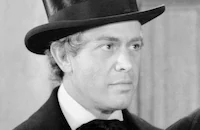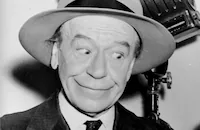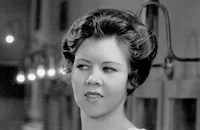Maid of Salem
Brief Synopsis
Cast & Crew
Frank Lloyd
Claudette Colbert
Fred Macmurray
Harvey Stephens
Gale Sondergaard
Louise Dresser
Film Details
Technical Specs

Synopsis
In 1692, in a milieu of Puritan ethics which are strictly enforced by church elder Nathaniel Goode, the women of Salem, Massachusetts become fascinated with stories about Satan told to them by Tituba, a slave in the Goode household. Meanwhile, Barbara Clarke, who lives with her widowed Aunt Ellen and her son Timothy, meets fugitive Roger Coverman, who fled Virginia after being pronounced a traitor for resisting taxation. In love with Roger's free spirit, Barbara continues to meet him in secret. As the town's fear of the occult grows, two women are arrested for witchcraft at Cape Ann. Virginia Goode then steals her father's book on witchcraft, and, caught by Tituba, she is punished by her father and schemes for vengeance against Tituba. During the height of the town's hysteria and paranoia, Virginia feigns a hallucinating fever which convinces the parish elders that she is also a victim of Tituba's witchcraft. The slave is arrested and forced to confess, implicating two other town innocents as well. Barbara boldly moves to defend Tituba until Aunt Ellen reveals that Barbara's mother was accused of witchcraft and hanged in England. To escape the frenzy of Salem, Roger leaves with his recluse uncle, Jeremiah Adams, for Florida (which is under Spanish rule) via Boston, but Jeremiah is killed by seamen who seek the reward for Roger's arrest, and he is put in jail. Back in Salem, when a harmless old woman named Rebecca Nurse is sentenced to die at "Gallows Hill" by the Cheeves, a couple who carries an old grudge against her, Barbara defends her and is accused of being a witch herself. Timothy, who saw Barbara kiss Roger good-bye in the night, tells the court Barbara had assured him she was with "no man" and the judge twists his testimony into an admission of Barbara's consorting with the Devil. Meanwhile, Roger escapes from prison, ironically on the day the new governor of Virginia arrives with his pardon, and makes his way to Salem, where fifteen people have now been hanged for witchcraft. During Barbara's trial, she refuses to confess to being a witch, but, because she must protect Roger's anonymity, is unable to prove that she was not with Satan. When Barbara's friend John rises to defend her, his wife Martha, fearing it was John whom Barbara was with, reveals the truth about the death of Barbara's mother, sealing her fate. As Barbara is about to be hanged, Roger finally arrives, solving the mystery of Barbara's lover. Virginia then admits that it was spite that made her incriminate Tituba. Finally realizing that all were wrongfully accused, Crown Justice Sewall appeals to the governor to abolish the trial for witchcraft. As Barbara is let out of prison, she and Roger embrace. The governor then orders that the tree at Gallows Hill be burned, and the villagers set fire to it.

Director
Frank Lloyd
Cast

Claudette Colbert

Fred Macmurray

Harvey Stephens

Gale Sondergaard
Louise Dresser
Bennie Bartlett

Edward Ellis

Beulah Bondi

Bonita Granville

Virginia Weidler

Donald Meek

E. E. Clive

Halliwell Hobbes
Pedro De Cordoba
Madame Sul-te-wan
Lucy Beaumont

Henry Kolker

William Farnum

Ivan Simpson

Brandon Hurst

Sterling Holloway
Zeffie Tilbury
Babs Nelson

Mary Treen

J. Farrell Macdonald
Stanley Fields
Lionel Belmore
Tom Ricketts
Guy Bates Post
Kathryn Sheldon
Rosita Butler
Madge Collins
Amelia Falleur

Clarence Kolb
Russell Simpson
Colin Tapley
Chief Big Tree
White Bird
Harold Entwistle
Harold Nelson
Hayden Stevenson
Thomas L. Brower
Edwin Mordant
Ray Hanford
Wade Lane
John Power
James Marcus
Jack Deery
Clive Morgan
Colin Kelly
Sidney D'albrook
Hal Cooke
Joseph Tozer
Dave Dunbar
John Spacey

Harry Cording
Grace Kern
Wally Albright
Jack H. Richardson
Jack Daley
George Magrill
Charles Mcavoy
Vangie Beilby
Tommy Bupp
Ricca K. Allen
Agnes Ayres
Wilson Benge
Sidney Bracy
Fritzi Brunette
Herbert Evans
Fryda Gagne
Edith Hallor
Frank H. Hammond
Carol Holloway
Harold Howard
Ward Lane
Stella Le Saint
Ralph Lewis
Vera Lewis
Anne O'neal
Rita Owin
Audrey Reynolds
Allen D. Sewall
Walter Soderling
Al Stewart
William Wagner
Elsie Prescott
Crew
Travis Banton
Lance Baxter
Hugh Bennett
Hans Dreier
Howard Estabrook
Walter Ferris
A. E. Freudeman
Durward Grinstead
Bernard Herzbrun
Bradley King
Bradley King
William Lebaron
Gene Merritt
Louis Mesenkop
Boris Morros
Leo Tover
William Tummel
Harlan Ware
Victor Young
John Zinn
Adolph Zukor

Film Details
Technical Specs

Quotes
Trivia
Notes
A written prologue that opens the film states that the story was based on "authentic records of the year 1692." According to the film's pressbook, the sermon preached by Rev. Samuel Parris was taken "almost wholly" from a rare collection of sermons by Reverend Deodat Lawson, who served with Parris at Salem Village. As reported in the pressbook from information found in the Essex Museum in Salem, in Puritan days, there were two Salems: Salem Town, on the seacoast, which is now modern Salem; and Salem Village (now called Danvers), a farming community located seven miles inland, where most of this film is set. The film was shot on location on a farm four miles outside of Santa Cruz, CA, where Paramount reproduced the Salem countryside on forty acres of land. A sailor's shanty was built on a bluff overlooking the Pacific Ocean at Carmel, CA. According to the pressbook, the British Museum supplied two ancient songs for the film: a sea chanty written in 1530 and a ballad, "Bid Me But Live," ca. 1630, which was sung by Fred MacMurray in the picture. According to a January 26, 1937 news item in Hollywood Reporter, an eight-hundred foot trailer was being prepared featuring director Frank Lloyd in the cutting room. "Action" scenes shot through the Moviola were also included.
According to files in the MPAA/PCA Collection at the AMPAS Library, on May 14, 1936, Joseph I. Breen, Director of the PCA, wrote to Paramount distribution executive John Hammell with his reaction to an outline of Bradley King's story, which was called "Between Two Worlds." Breen requested that Hammell have his research department verify whether alleged witches were actually burned in Salem. Breen wrote, "It is our impression that there were no burnings-rather was the alleged punishment confined to hangings." The film's program included the following note: "The widely held belief that there were witch burnings doubtless arises from witchcraft annals in England and France (most notably Joan of Arc) where there were many burnings. This, however, was never true in America." In reference to a kiss between Roger and Barbara, the PCA cautioned the filmmakers in a letter dated August 27, 1936: "they should, of course, not be lying on the ground." Further caution was expressed about the portrayal of the clergy: "While there is of course ample historical grounds to prove that many of the clergy were caught up in the hysteria of the time, it might be well to counter-balance this in your picture by introducing briefly another minister [besides Reverend Samuel Parris] who will typify the more rational element among the clergy." On August 28, 1936, Breen wrote to Hammell, quoting the Production Code, "Ministers of religion in their characterizations of ministers should not be used in comedy, villains, or as unpleasant persons," and warning Hammell to "make definite changes in your script RE: Rev. Parris to bring picture in compliance with above Code provisions." An inter-office memo dated August 31, 1936 from Geoffrey Shurlock, Breen's assistant, outlines Hammell's response to the previous letter. The memo states: [director Frank] "Lloyd aware of danger in portrayal of the minister. Rev. Parris, played by [Ivan] Simpson, will portray him as stern upright minister, but with no tinge of the blue nose about it. They are also cutting out most, if not all, of the scenes in which minister is shown (in script) actually connected with the witch-hunting. [They also will be] introducing the character of another minister who will represent the liberal viewpoint, and who will protest against the witch-hunting hysteria of the time."
According to a news item in Hollywood Reporter on December 29, 1936, following a sneak preview of the film, Paramount decided to revise the ending, and recalled the company back for a few days of retakes. A script dated October 15, 1936 in the Paramount Script Collection at the AMPAS Library indicates that in the preview version, after Roger saves Barbara from being hanged, Sewall calls an end to the witchhunt, and Barbara collapses into Roger's arms. Elder Goode then realizes Virginia has lied, and Sewall prays to God for forgiveness. A member of the mob then calls for the burning of the tree at Gallows Hill, and the film ends. In the script to the revised final reel dated December 29, 1936, the governor signs a decree abolishing the trial for witchcraft and orders the tree at Gallows Hill to be burned. (The signing of a proclamation that freed prisoners of the witchhunt appeared in an early script, but had been removed by 1 September 1936.) Later Barbara emerges from her dungeon cell, where she embraces Roger. The tree is then burned. In an early script dated August 22, 1936, John is struck by a soldier while defending Barbara at her hanging and dies. According to contemporary news items, this film was screenwriter Howard Estabrook's first producing assignment for Paramount. Some reviews erroneously credit Russell Simpson as "Rev. Samuel Parris." Russell appears as "Village marshal," and Ivan Simpson appears as "Rev. Samuel Parris."












